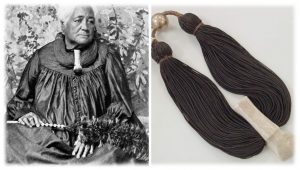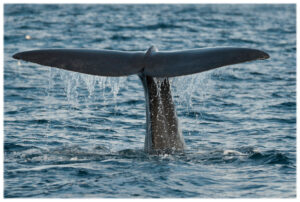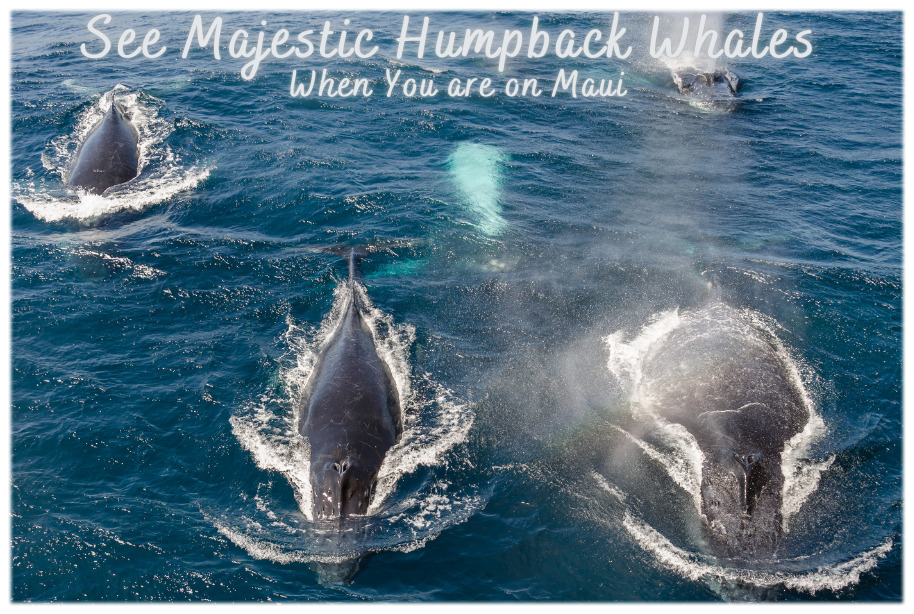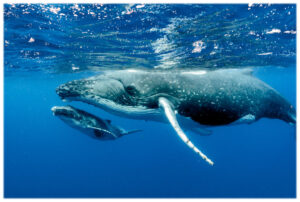 Their Hawaiian name is Koholā*
Their Hawaiian name is Koholā*
The humpback’s high status in Hawaiian culture has been made clear in the Kumulipo*. This creation chant announces the birth of the whale near the beginning, in the second section. That is a very high ranking in a 2,102 line chant.
Hanau ka palaoa noho i kai — born is the whale living in the ocean.
 Whales Were Here Before People!
Whales Were Here Before People!
Graceful and awe-inspiring, the magnificent North Pacific Humpback Whales return to the tranquil waters of Hawai’i every year as they have done since 100/400 AD. A time before the first Hawaiians arrived. They come for the same reasons now, to have a safe sanctuary where they can compete for a mate, breed, give live birth, and play.
Once you encounter these gentle giants up close, you will find yourself awestruck and mesmerized. You will never forget the slow-motion elegance and intelligence they possess. Plus, many people can feel their presence in a way we usually only feel another human’s presence.
In the old religion, it is also believed that Koholā was the manifestation of the Hawaiian God, Kanaloa*.
Kanaloa is one of the four major Gods of traditional Hawaiian religion. We know he is associated with whales and other sea life, along with the ocean, long-distance voyaging, and healing.
Whales, like all creatures of nature, were highly respected by the Hawaiian people.
Ancient whale tooth necklaces, called Niho Lei Palaoa* were worn by high-ranking Hawaiian chiefs, chieftesses, and the Ali’i*. They were thought to represent power and strength, and served as a vessel for mana*.
These necklaces were the second most valuable artifact an Ali’i could possess.


Here is an ‘Ōlelo No’eau* that connects the Hawaiian people to koholā.
(Hawaiian Proverb)
O luna, ‘o lalo, ‘o uka, ‘o kai, ‘o ka palaoa pae, no ke Ali’i
Above, below; the upland, the lowland, the whale that washes ashore — all belong to the chief.
The chief owned everything in the land he ruled. Ivory obtained from the teeth of whales that washed ashore was very valuable.

North Pacific Humpback Whales and their connection to Hawaiian culture and beliefs is deeply interwoven in Hawaiian legends and folklore.
Some people still feel a powerful connection to the Whales and get out on the water as much as possible to be with them during Whale Season*.
5 Interesting Facts About Maui’s Whales

- North Pacific Humpback whales do not actually have a hump. Instead, the name comes from what appears to be a hump when they arch their backs before a deep dive. Following the arching back, next, the famous tail. They will stay down below the surface without taking a breath for at least 20 minutes or more.
- Humpback whales depart the icy waters of Alaska in the fall for Hawai’i. They come to compete for a mate, to breed, to give birth, and to play. In Maui, the underwater visibility from the crystal clear water is exceptional. The variety of shallow (800’) and deep (18,000’) waters mixed with no natural predators gives them an ultimate safe space to raise and nurture their young calves safely.
- Koholā have live births. Their pregnancy cycle lasts for about one year. Once the calves are born, they drink about 150 gallons a day of thick milk, which is the consistency of cottage cheese. They stay with their mother for a year, until their return to Maui.
- In Alaska, they eat 5000 pounds of plankton, krill, and small fish every day in two servings. Their feeding season in Alaskan cold waters lasts for 120 days. There is nothing for them to eat in Hawai’i. Hawaiian waters are crystal clear, meaning, they have no food for the whales. They play, birth, mate, and then go back to Alaska to eat in the rich, green Alaskan waters in the springtime. Only the calves will be fed from their mothers while they are here in Maui.
- The male whales sing! They often perform their songs during the mating season. Many believe the purpose of songs is to find their mate. Another belief is that it helps them to explore their new area. Get their bearings. When a male humpback moves to a new spot, he changes his song to match those coming from other nearby whales. We think they may be communicating with each other. Their song can be heard at a distance of 12 miles.
There is still so much to learn about these gentle giants.
You can see them and hear their sweet song HERE
It is impressive that they travel back and forth from Alaska to Maui every year. The babies are primarily born in Hawaii’s warm waters and grow sufficiently during their time around the islands to be strong enough to make the trip back to Alaska’s cold waters in the spring.
Hawai’i is their sanctuary.
Here is the Hierarchical Order of Arrival to Maui:
- The first to arrive are the mother whales, who are nursing their calves that were birthed the year before.
- Next up is the juveniles, then the adult males, followed by adult females.
- The last to arrive are the pregnant females. They come last because they feed and nourish themselves until the very last minute in Alaska.
North Pacific Humpback Whales have returned year after year to thrill people in Maui — locals and visitors alike. Each whale season is different.
We are just starting to see the first of this year’s arrivals as we write this.
You can view them from the shore, on a boat, or from an aircraft! They have been spotted now and then from the helicopter ride to Hana, on our Hana Sky-Trek.
Planning One of Your Visits to Come During Whale Season Is a MUST!
On the water is one of the best ways to experience the whales up close. Be it on a boat, stand-up paddleboard, kayak, or inner tube. When you are underwater, listen for their songs.
Their songs travel for miles, so sometimes it sounds like a big cocktail party underwater as the whales returning to Maui sing back and forth to each other about their adventures. Unfortunately, we cannot hear the part of their songs that they sing at very low frequencies. But there is still plenty of singing to be heard!
The magic of sharing the sea with these majestic and glorious fellow mammals is life-altering. We hope you can join us on Maui for Whale Season.
And of course, adding the allure of the Road to Hana with Temptation Tours is the perfect adventure to enhance your time and overall outstanding experience of Maui.
Writing and Graphic Design by Sugandha Ferro Black
GLOSSARY* of Hawaiian Words
Ali’i – Aliʻi in the Hawaiian language refers to the hereditary line of rulers of the Hawaiian Islands.
Kanaloa – the god of the sea, the divine and supreme Hawaiian demigod of ocean animals
Koholā – North Pacific Humpback Whales
Kumulipo – the Hawaiian chant of creation (2,102 lines long)
Mana – a spiritual energy from the gods and their ancestors, the spiritual life force energy or healing power that permeates the universe
Na Koholā – plural for whales
Niho Lei Palaoa – whale tooth necklace
‘Ōlelo No’eau – Hawaiian proverb. All were written by Mary Kawena Pukui
Whale Season – November to May with peak time being January to March
*Please keep in mind that all Hawaiian Words have many meanings. The meanings we share here are the specific translations for the words as they pertain to this particular blog’s subject matter.
Photos courtesy of paid for or other free sources unless otherwise noted.
Chieftess Mele Kaupoko with Lei Niho Palaoa is Public Domain, along with the image of the CCOLei Niho Palaoa.


